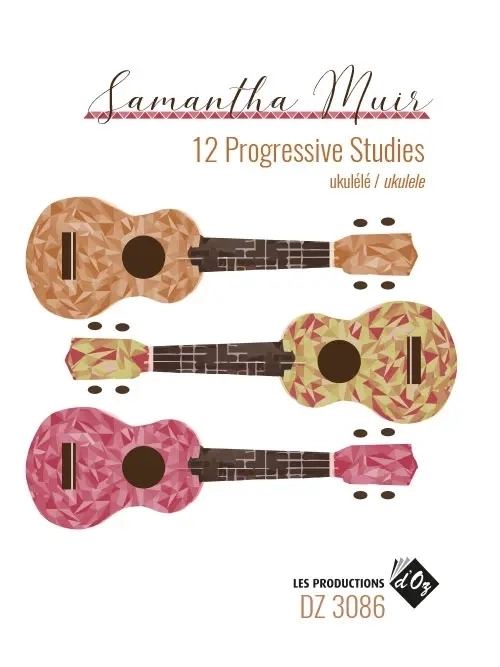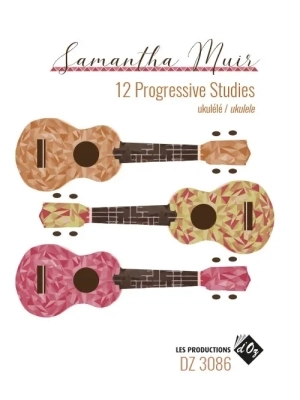Opens in a new window
Les Productions d'Oz 12 Progressive Studies for Ukulele - Muir - Ukulele - Book

Additional Photos:

- Author/Composer:
- MUIR, SAMANTHA
- Instrumentation:
- UKULELE
- Model #:
- DZ3086
Format: Book
Instrumentation: Ukulele
Most of the current repertoire for classical ukulele consists of arrangements borrowed from the classical guitar canon. Having given numerous classical ukulele workshops at festivals throughout the UK I realised there was a real need for pieces which are both pedagogical and idiomatic to the ukulele. These 12 studies are designed to help players develop their technical skills while improving their facility around the fingerboard. The pieces become progressively more challenging ranging from easy to intermediate level.
1. Adrian's Song An easy piece in first position. The thumb plays the bass notes while the index and middle fingers alternate to play the melody notes. The piece is a tribute to the French composer and renaissance guitarist Adrian Le Roy (1520-1598). The renaissance guitar had much in common with the ukulele being similar in size to a tenor ukulele but with four courses, or double strings.
2. New Bransle Another piece inspired by the renaissance guitar works of Adrian Le Roy. The right hand thumb jumps from fourth string to third string playing the bass while the index and middle fingers play the melody. The piece is in first position, making it straightforward for the left hand, while the right hand is kept busy moving across the strings. Aim for a lively tempo.
3. Open Dance The main aim of this piece is to cultivate an accurate and rhythmical right hand plucking technique. There is a lot of movement across the strings and it is important to use alternating right hand fingering. Keep the hand steady and move the fingers from the knuckles. The left hand doesn't have a lot of work to do so it's a good opportunity to focus on the right hand.
4. Sunday Stroll An arpeggio study in three sections, or A B A. The piece uses simple chord patterns in the left hand with the right hand playing arpeggios. The A section is a straightforward p i m i m i m i pattern. The pattern of the B section is less intuitive - m i p i p i m i - and will take more practise. This section sounds most effective if the notes on the A string are given more emphasis.
5. Spring Dance The left hand has more work to do in this piece. All the semiquaver figures should be played as a hammer-on. To do this pluck the first, or lower note with the right hand finger. The second note is then sounded by hammering-on to the next note with the relevant left hand finger. The key to creating a good, clear sound is accuracy. Make sure the finger lands cleanly on the string right behind the fret.
6. The Dusting Song Ukulele players often refer to the fingerboard beyond the seventh fret as the dusty end because they don't play up there very often. In this piece the melody moves up and down the fingerboard while the accompaniment is kept simple using the open strings. Play the open strings softly and let the melody sing. When shifting position slide the finger along the string up the fingerboard to create a smoother, more legato feel. If you haven't played up this end of the fingerboard you will be doing some dusting! The twelfth fret note at the beginning of bar 24 can be played as a harmonic. To create the harmonic lightly touch the first string over the twelfth fret. Pluck the string with the right hand finger and then release the left hand finger to sound the harmonic.
7. Blue Buggly This was originally written as a workshop piece for the Bidduph Ukulele Group. The piece is in two sections and has a bluesy feel. The first section uses a shifting triplet pattern across the fourth, third and second strings with the left hand moving from eighth position, to third position, to first position. The patterns end with strummed chords. The second section is an arpeggio moving mostly in quavers. The melody moves up and down the first string. The phrases end with a strummed chord: you can either use the side of the thumb, for a softer effect, or the back of the index finger nail, for a more strident sound. The quavers should be played with a slight swing feel.
8. Flow River Flow A flowing piece in 6/8 time. The first and second fingers of the left hand stay planted on strings two and three as they move up and down the fingerboard. Meanwhile the right hand fingers play a repeated p i m pattern across the strings. The phrases end with a slight change in the pattern to either p i m a or p i m p. The piece should sound very smooth and fluid, effortless yet powerful, like a flowing river. Some subtle rubato helps to give the feeling of ebbing and flowing. Rubato is a gentle quickening or slackening of the tempo to add expression without altering the overall tempo.
9. Waltz Falabella A falabella is a breed of miniature horse. I chose the title as this piece is a miniature waltz. The arpeggio moves up and down the fingerboard using familiar chord shapes. When writing this piece I had the image of a little horse trotting very prettily so aim to make the shifts as clean and elegant as possible.
10. Waltz Variations A set of variations on Waltz Falabella which explore a number of different right hand techniques. The opening bars require two notes to be plucked simultaneously by the index and middle fingers. Bars 5 to 8 use a tremolo technique with p plucking the bass followed by a m i playing rapid repeated notes. The chords from bar 17 to 24 work well with the thumb playing a quick brush stroke across three strings.
11. The Waking This piece is a combination of arpeggios and campanellas ('little bells'). The notes should ring on and over each as much as possible to create the full effect of bells. Make sure the slurs, or hammer-ons, are even. The straight line between the D and C in bar 4 indicates a slide. Like the slur the second note is not plucked with the right hand. The sound is produced by the left hand finger sliding into position on the string. The piece should have a gentle, lilting feel.
12. Tom Thumb's Study A real workout for the thumb as it alternates between the third and fourth strings. The melody has a bluesy feel and should be played with a swing rhythm. If you don't have a 15th fret on your ukulele to play the high C you can play a 12th fret A. I didn't include a tempo marking for this piece, just the option to interpret 'crazy' however you feel it. This piece has more of a jerky, staccato feel than the others. The challenge is to keep the thumb constantly moving back and forth while the fingers bring out the melody.
Q & A
There are currently no questions for this product.
Reviews
There are currently no reviews for this product. Be the first to write one!




